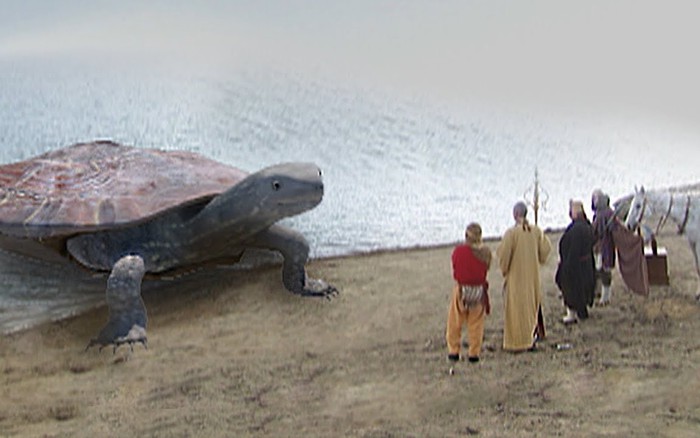The real “water monster” in Journey to the West
In “Journey to the West”, a classic work of Chinese literature, there is a part about the four monks and disciples of Tang Sanzang when they went to get the scriptures and needed to cross the Tongtian River. Due to lack of means, they asked for help from a giant “old turtle” to carry them across the river. The old turtle asked Tang Sanzang to ask Buddha about his 1,300 years of cultivation without being able to transform into a human. However, when Tang Sanzang returned, he forgot about this and did not fulfill the old turtle's request. This incident led to all four monks and disciples being thrown into the river by the old turtle and their scriptures getting wet. This story was the 81st disaster they had to overcome on their journey.


Image of the Giant Turtle in the TV version of Journey to the West
To this day, many people are still curious about the origin of the turtle character, whether it is a monster or just a normal animal. Wu Cheng'en, the author of “Journey to the West”, is praised for his creativity when he created many unique and interesting characters such as the Old Turtle. However, the giant turtle in Journey to the West is not fictional and only exists in books. This incredibly large turtle species completely exists in real life.
Interesting facts about giant turtles
Through scientific research, giant turtles really did exist on Earth, and are not just a product of the imagination. The scientific name of this turtle is Stupendemys geographicus, which means “giant turtle”. It is an ancient turtle species with fossils discovered in northern South America, existing from the Miocene to early Pliocene periods, about 13 to 5 million years ago.
Fossils show that the Stupendemys geographicus turtle had a shell length of about 4 meters, and a total body length of more than 5 meters, with a weight of more than 5 tons. This size allowed them to carry several people on their backs at the same time. Several fossils of this turtle have been found in various places in South America, usually living in ponds, lakes of tropical rain forests or slow-flowing rivers, and they mainly ate plants.


Evidence of giant turtles that once existed on Earth
One of the most remarkable discoveries was the nearly complete fossil specimen discovered by a team of Venezuelan paleontologists, which showed features such as long horns in males, which developed at the front of the shell and on both sides of the neck, helping them defend themselves against predators. This turtle had only one natural enemy, the Purussaurus crocodile, which is also extinct since the Miocene.
The fossils of Stupendemys geographicus are considered to be the largest turtles ever discovered. Its closest modern relative is Podocnemis expansa, which lives in the swamps of South America and is about 1 meter long and weighs an estimated 90 kilograms. The fossils also reveal genetic links between Stupendemys geographicus and many turtles that live in the Amazon region today.
Source: Sci News